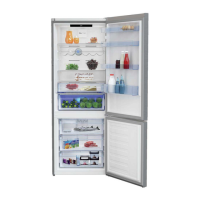
Do you have a question about the Beko RCNE560E40ZXBN and is the answer not in the manual?
| Door hinge | Right |
|---|---|
| Control type | Buttons, Touch |
| Product color | Silver |
| Reversible doors | Yes |
| Custom panel-ready | - |
| Appliance placement | Freestanding |
| Freezer position | Bottom-placed |
| Freezing capacity | 6.5 kg/24h |
| Freezer net capacity | 145 L |
| Freezer door balconies | 0 |
| Freezer gross capacity | 560 L |
| Freezer interior light | No |
| Freezer number of shelves/baskets | 3 |
| Storage time during power failure | 24 h |
| Noise level | 38 dB |
| Climate class | SN-T |
| Current | 0.8 A |
| Connected load | 150 W |
| AC input voltage | 220 - 240 V |
| AC input frequency | 50 Hz |
| Energy efficiency scale | A to G |
| Annual energy consumption | 304 kWh |
| Lamp type | LED |
| Fridge net capacity | 356 L |
| Fridge door balconies | 4 |
| Sustainability certificates | ENERGY STAR |
| Package depth | 832 mm |
| Package width | 747 mm |
| Package height | 1978 mm |
| Package weight | 90000 g |
| Depth | 745 mm |
|---|---|
| Width | 700 mm |
| Height | 1920 mm |
| Weight | 88000 g |
Covers general safety guidelines for operating the refrigerator, including user responsibilities and potential hazards.
Details specific safety precautions related to the use of hydrocarbon refrigerants like R600a to prevent fire risks.
Provides installation and usage instructions for models equipped with water dispensers or ice machines.
Specifies the designed purpose of the appliance and limitations for domestic use only, not commercial.
Outlines essential safety measures to prevent children from accessing, playing with, or getting trapped inside the appliance.
Locates the control button used to set and adjust the appliance's internal temperature settings.
Guidance on selecting an appropriate location for installing the refrigerator, considering ventilation and heat sources.
Details on how to safely connect the refrigerator to the electrical power supply, including important warnings.
Tips and instructions for optimizing the refrigerator's energy consumption and efficiency.
Guidance on initial setup and operation of the refrigerator before regular use, including pre-cooling.
Explanation of the control panel symbols, indicators, and their functions for operating the appliance.
Guidelines for rapidly freezing fresh food items to preserve quality and extend storage time effectively.
Advice on optimal temperature settings and practices for storing frozen food items for maximum shelf life.
Technical specifications and guidelines for the deep freezer compartment's performance and food preservation capacity.
Recommendations on where to place different types of food within the refrigerator for optimal storage and air circulation.
Tips and methods to prevent unpleasant odors from developing inside the refrigerator by maintaining cleanliness.
Instructions for cleaning the interior of the refrigerator and all its removable parts safely.
Troubleshooting steps for when the refrigerator fails to power on or function correctly.
Explains common causes and solutions for condensation appearing on the refrigerator's side walls.
Troubleshooting steps for issues related to the compressor not running, including power and thermal protection.
Explains why the refrigerator might run for extended periods, considering factors like temperature and usage.
Troubleshooting steps for when the freezer is excessively cold relative to the fridge compartment.
Troubleshooting steps for when the fridge is excessively cold relative to the freezer compartment.
Addresses issues where the internal temperatures of the fridge or freezer compartments are too high.